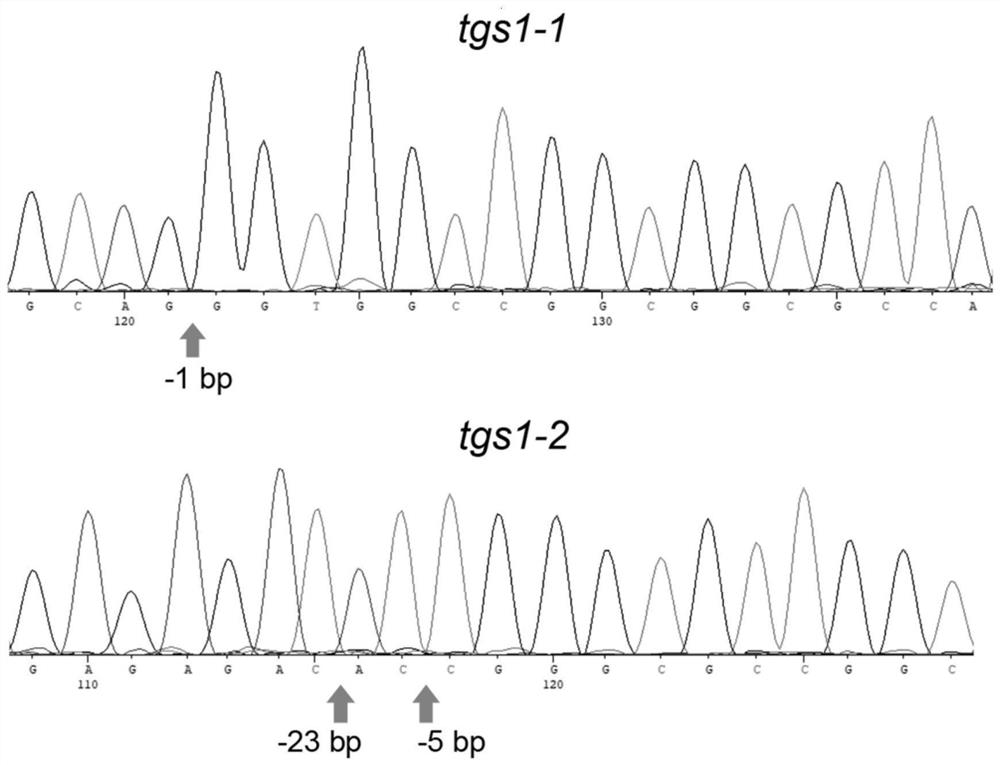Application of TGS1 gene in regulation and control of size and yield of Oryza sativa L. grain
A rice grain, 1. TGS1 technology, applied in the fields of molecular biology and genetic engineering, can solve the problems of new genes to be identified and limited knowledge, and achieve the effects of shortening the breeding cycle, high commercial value, and high yield
- Summary
- Abstract
- Description
- Claims
- Application Information
AI Technical Summary
Problems solved by technology
Method used
Image
Examples
Embodiment 1
[0033] Example 1: Method for Knocking Out TGS1 Gene to Increase Rice Grain Size and Yield Based on CRISPR / Cas9 Technology
[0034] The sequence of the gene TGS1 is shown in SEQ ID No.1. Sequence analysis showed that the gene consisted of 3 exons, which were the 1st-287th (1st exon), 988-2512th (2nd exon) and 988th-2512nd (2nd exon) of the sequence of SEQ ID No.1. Positions 2647-3012 (exon 3).
[0035] (1) Construction of TGS1 gene knockout recombinant expression vector
[0036] Design the CRISPR / Cas9 gene knockout target site in the coding region of the TGS1 gene, targeting the antisense strand of the second exon, and the target sequence is shown in SEQ ID No.5. Synthesize target sequence primers based on the CRISPR / Cas9 system, the sequence is as follows:
[0037] TGS1-P1: 5'- TGTG GGCGCCGCCGGCCACCCCTG-3',
[0038] TGS1-P2: 5'- AAAC CAGGGGTGGCCGGCGGCGCC-3',
[0039] The underlined part is the cohesive end used for vector ligation, and the ununderlined part is the tar...
Embodiment 2
[0059] Embodiment 2: Construction of TGS1 overexpression strain
[0060] In order to further verify the function of the gene regulating rice grain size, an overexpression line of the gene was constructed. Use a pair of PCR primers to amplify the complete coding sequence of TGS1, digest it with restriction enzyme Bsa I (NEB), and connect it into the downstream of the ZmUBI promoter of the pEGOEPubi-H vector with hygromycin resistance gene to construct pEGOEPubi- H-TGS1 overexpression transgene vector. The sequence of the pEGOEPubi-H-TGS1 overexpression transgene vector is shown in SEQ ID NO.12. The PCR primer sequences are as follows:
[0061] TGS1OE-F:
[0062] 5'-ACTAG GGTCTC GCACCATGCCGCCATTCTCGGCAGCCG-3',
[0063] TGS1OE-R:
[0064] 5'-ACTAG GGTCTC TACCGTCACTGGACGCAGGCCAAGAATGA-3',
[0065] Wherein the underlined part is the recognition site of Bsa I.
[0066] Referring to the method of Nishimura et al. (Nishimura A, Aichi I, Matsuoka M.A protocol for Agrobacteri...
PUM
 Login to View More
Login to View More Abstract
Description
Claims
Application Information
 Login to View More
Login to View More - R&D Engineer
- R&D Manager
- IP Professional
- Industry Leading Data Capabilities
- Powerful AI technology
- Patent DNA Extraction
Browse by: Latest US Patents, China's latest patents, Technical Efficacy Thesaurus, Application Domain, Technology Topic, Popular Technical Reports.
© 2024 PatSnap. All rights reserved.Legal|Privacy policy|Modern Slavery Act Transparency Statement|Sitemap|About US| Contact US: help@patsnap.com










